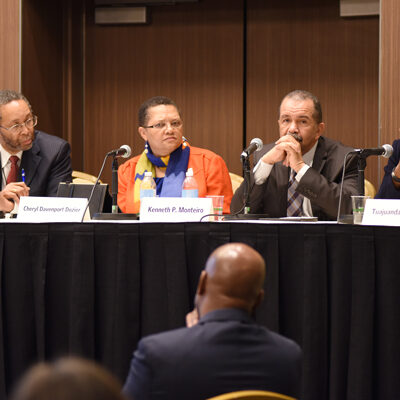By Kim Bobby
Following our series on campus climate and student protests, ACE’s Kim Bobby discusses effective processes for building and retaining a diverse faculty—and how true inclusivity takes individual self-reflection and action.
There has been a great deal of energy expended on diversifying the faculty on college campuses in recent years, and the discussion has ramped up lately with the focus on student protests and demands for a more inclusive campus climate. Higher education is supposed to expand our worldview, and the reality is that a racially and ethnically diverse faculty creates a different conversation in departments and moves us closer to achieving that goal. Across disciplines, a diverse faculty brings a different lens to curriculum development and enriches faculty members themselves along with the learning outcomes envisioned for students. However, the real work in achieving these important goals starts with an honest examination of the campus climate and the readiness to commit to hiring, retaining and promoting a more diverse faculty.
We often hear the familiar lament that there are not enough talented individuals of color in the pipeline or in a particular discipline to be viable candidates in a search, or that those individuals who are ready are superstars and too costly to recruit. I have often heard colleagues reference tenure as more permanent than marriage. As a result, there is a level of anxiety and fear associated with making a commitment to bringing colleagues who have different lived experiences and scholarship into the departmental family. The faculties of color who are in the pipeline also need a network of retention support, made up of a range of campus stakeholders—from senior leadership to department colleagues and students.
Addressing departmental and campus climate are critical elements in successfully recruiting and retaining faculty of color. During a recent convening at ACE where tenure-track faculty of color, provosts and chief diversity officers met, much of the discussion focused on the current reality for many of these faculty members as they navigate through microaggressions, cultural taxation and a difficult campus climate.
When describing microaggressions, one participant said, “faculty of color are expected to be exceptional teachers. If they are, they are not rewarded, but if they are not, then they are viewed as terrible in teacher evaluations, particularly from white male students. Students question their authority and many women faculty are referred to by their first names.”
Individuals in the department often deliver cultural norms and override any stated commitment to diversity. As one participant reflected, “I wasn’t surprised that I had to deal with microaggressions from students, but I was shocked that I had to deal with them from faculty members. I overheard tenured professors make racist comments and I didn’t know what I could do about it. Having to deal with those “little cuts” was hard. People leave jobs when they feel like they can’t talk about it. It is important that the benefits of diversity be understood across campus and across tenure lines.”
This means that harmful departmental cultural norms are visible, and the work of changing them rests on the shoulders of each individual in the department.
Cultural taxation is a term coined by Amado Padilla in 1994 to describe the unique burden placed on ethnic minority faculty in carrying out their responsibility and service to the university. Padilla defined cultural taxation as the desire to take on service to an institution by representing its needs for racial or ethnic representation on committees, or to demonstrate insider knowledge and commitment to a cultural group.
The truth is that many faculty of color feel an obligation and commitment to stepping into these spaces. But the benefits for the faculty member and the institution are uneven. While these faculty perspectives and service bring richness to the campus culture and climate, they are not usually rewarded by the institution on whose behalf the service was performed. The impact of cultural taxation is gaining increased awareness, and researchers are beginning to look into ways to lessen its effects.
I had the opportunity recently to speak at the retreat of the Association of Schools and Programs of Public Health. The discipline itself requires engagement across difference when addressing public health research and practice. Speakers and attendees alike acknowledged that a common theme in student demands for change called for greater faculty diversity. This association values inclusive practices and was seeking examples of how to build capacity for change in hiring and retention practices to achieve greater faculty diversity.
I was invited to present on a project I started with former colleagues at the University of Puget Sound (WA), where I served for five years as the first chief diversity officer and clinical associate professor in the School of Education. Our project report, Diversity Narratives: Classroom Moments of Unanticipated Student Spotlighting, was designed to assist faculty in working through critical moments of inclusion or exclusion in the classroom. The project had three goals:
1) to help faculty members grow the “muscle” to step onto spaces where a student had been spotlighted as “other” or as the “text” to represent the perspective of an entire marginalized or underrepresented group,
2) to address the cultural taxation put upon faculty of color or faculty representing underrepresented groups by increasing the numbers of white faculty who were willing to step into these spaces in the classroom and expand their engagement campus wide allies, and
3) to demonstrate that faculty across disciplines experience these moments, and that sharing them creates a culture of trust and builds capacity for addressing unanticipated moments in the classroom where we know someone is feeling pain and wants the faculty member to step in to address the tension.
The narratives I shared included stories about racialized, religious and gendered moments in the classroom where faculty members were stunned and paralyzed, and their reflections on what they would do if they had it to do over. I reminded the audience that the key was not to judge, but to think about the benefits of sharing these stories. I asked them to name some potential positive outcomes that may result from capturing and sharing these moments, and ask how might this type of sharing impact the faculty, students and the department.
When addressing how to retain faculty of color and build a skill set for all faculties to help achieve inclusivity, the entire campus collectively becomes stronger. Many of the participants spoke with me about initiating this project on their campus. There was a desire for greater understanding about cultural taxation and how this project could be used as way to address it.
Our college campuses are a part of the larger community, and we are at a pivotal moment where healing needs to occur due to increased social unrest, fear, violence and injustice. The college classroom is a critical site where these issues will surface and it is also a place where healing can begin. Our students are demanding it.
If you have any questions or comments about this blog post, please contact us.


